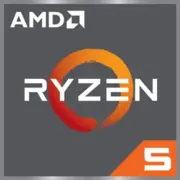AMD Ryzen 5 PRO 6650U

AMD Ryzen 5 PRO 6650U: The Balance of Mobility and Performance in 2025
Review of the processor for modern ultrabooks and business laptops
Architecture and Technology: Zen 3+ on 6 nm
The codename Rembrandt, which underpins the Ryzen 5 PRO 6650U, represents an evolution of the hybrid Zen 3+ architecture. The processor is manufactured using TSMC's 6 nm FinFET process, providing improved energy efficiency compared to the 7 nm process of previous generations.
- 6 cores and 12 threads with a base frequency of 2.9 GHz and turbo mode up to 4.5 GHz.
- 16 MB of L3 cache—twice as much as the Ryzen 5 5500U (7 nm), accelerating the processing of multithreaded tasks.
- Integrated Radeon 660M graphics based on the RDNA 2 architecture: 6 compute units (384 stream processors), clock speed up to 1.9 GHz.
The Zen 3+ architecture is optimized for laptops: the cores are grouped into a single cluster (CCD), which reduces cache access latency. The Radeon 660M graphics support DirectX 12 Ultimate, HDMI 2.1, and output to four displays.
TDP 15 W: Energy Efficiency Without Compromise
With a thermal package of 15 W, the Ryzen 5 PRO 6650U is designed for thin ultrabooks. However, thanks to Precision Boost 2 technology, the processor temporarily increases power to 25-28 W in turbo mode, maintaining a balance between performance and thermal output.
- Effective cooling: even in compact cases (14-16 mm thick), the cooling system handles the load.
- Dynamic control: the chip automatically adjusts frequencies based on temperature and load.
Performance: From Office Tasks to Light Gaming
Geekbench 6 test results (1690 / 6427) place the Ryzen 5 PRO 6650U on par with the Intel Core i5-1340P and Apple M2 (8-core version).
Real-World Scenarios:
1. Office Tasks (Chrome, Excel, Zoom):
- Simultaneous work with 30+ tabs and applications without lag.
- Rendering a 200-page PDF document—15% faster than the Ryzen 5 5600U.
2. Multimedia:
- 4K video conversion in DaVinci Resolve: 8 minutes compared to 11 minutes for the Core i5-1235U.
- Streaming in OBS: stable 60 FPS under CPU and iGPU load.
3. Gaming:
- CS2: 70-80 FPS at medium settings (1080p).
- Genshin Impact: 45-50 FPS (720p, medium graphics).
- For AAA games (Cyberpunk 2077), an eGPU or cloud gaming is required.
Turbo mode activates automatically when plugged in, adding 10-15% performance during rendering. In battery mode, the chip reduces frequencies to save power.
Who Would Benefit from Ryzen 5 PRO 6650U?
1. Students and Office Workers: multitasking capabilities and long battery life.
2. Freelance Designers: work in Figma, Adobe Photoshop, light 3D modeling.
3. Travelers: compact laptops weighing 1.2 kg or more (e.g., Lenovo ThinkPad Z13).
Not recommended for:
- Professional 4K video editing.
- Heavy gaming without a discrete graphics card.
Battery Life: Up to 12 Hours in Reading Mode
With a battery capacity of 60 Wh, laptops featuring the Ryzen 5 PRO 6650U demonstrate:
- 10-12 hours working with documents (brightness 150 nits).
- 6-7 hours watching YouTube (1080p).
- 3-4 hours in maximum performance mode.
Energy-saving technologies:
- AMD PowerNow!: dynamic switching between cores.
- Adaptive Power Management: optimizing load on SSD and Wi-Fi.
Comparison with Competitors
1. Ryzen 5 PRO 6650U:
- Geekbench 6 (Single/Multi): 1690 / 6427
- TDP: 15 W
- Graphics: Radeon 660M
- Laptop Price: $800-$1100
2. Intel Core i5-1340P:
- Geekbench 6 (Single/Multi): 1720 / 6100
- TDP: 28 W
- Graphics: Iris Xe (80 EU)
- Laptop Price: $900-$1300
3. Apple M2 (8-core):
- Geekbench 6 (Single/Multi): 1900 / 8900
- TDP: 20 W
- Graphics: Apple M2 (10-core)
- Laptop Price: $1100-$1500
Strengths of AMD:
- Better multithreaded performance than Intel.
- Support for Windows and Linux (limited support for Apple with macOS).
Pros and Cons
✅ Pros:
- Ideal for hybrid work (office + remote).
- Powerful integrated graphics for casual gaming.
- Support for DDR5 and PCIe 4.0.
❌ Cons:
- In 2025, competitors offer higher single-threaded performance (e.g., Apple M3).
- Limited selection of laptops with HDMI 2.1.
How to Choose a Laptop with Ryzen 5 PRO 6650U?
1. Type of Device: ultrabook (Acer Swift 5), business laptop (HP EliteBook 845 G9).
2. RAM: at least 16 GB LPDDR5.
3. Storage: NVMe SSD with 512 GB (1 TB recommended for backup).
4. Display: IPS matrix with a resolution of 1920×1200 and FreeSync support.
5. Ports: USB4 for connecting eGPUs or external monitors.
Examples of models for 2025:
- Lenovo Yoga Slim 7 Pro: 14" 2.8K OLED, 16 GB RAM, priced at $999.
- Dell Latitude 7440: 14" FHD, rugged chassis, priced at $1099.
Conclusion: Who Should Buy It?
The Ryzen 5 PRO 6650U is an optimal choice for those looking for a versatile laptop with 8+ hours of battery life and sufficient power for work and entertainment.
Key Benefits:
- Smooth performance in multitasking mode.
- Future-proof (DDR5, USB4).
- Affordable price: laptops starting at $800 versus $1100 for the MacBook Air with M2.
If you do not need maximum performance but value the balance of price and quality—this processor is for you.
Basic
CPU Specifications
Memory Specifications
GPU Specifications
Miscellaneous
Benchmarks
Compared to Other CPU
Share in social media
Or Link To Us
<a href="https://cputronic.com/en/cpu/amd-ryzen-5-pro-6650u" target="_blank">AMD Ryzen 5 PRO 6650U</a>